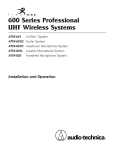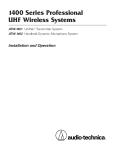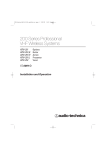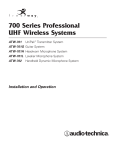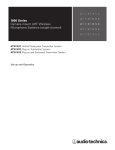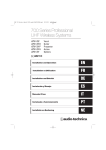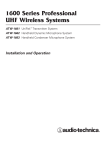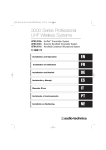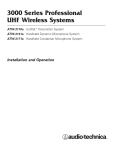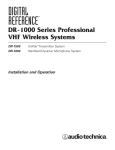Download Audio Technica 200 Series System information
Transcript
200 Series Professional VHF Wireless Systems ATW-201 UniPak™ System ATW-201/G Guitar System ATW-201/H Headworn Microphone System ATW-201/L Lavalier Microphone System ATW-202 Handheld Microphone System Installation and Operation Professional VHF Wireless Systems Installation and Operation This device complies with part 15 of the FCC Rules. Operation is subject to the condition that this device does not cause harmful interference. This device complies with INDUSTRY CANADA R.S.S. 210, en conformité avec IC: RSS-210/CNR210. Operation is subject to the following conditions: 1) This device may not cause harmful interference and 2) this device must accept any interference received, including interference which may cause undesired operation. CAUTION! Electrical shock can result from removal of the receiver cover. Refer servicing to qualified service personnel. No user-serviceable parts inside. Do not expose to rain or moisture. The circuits inside the receiver and transmitter have been precisely adjusted for optimum performance and compliance with federal regulations. Do not attempt to open the receiver or transmitter. To do so will void the warranty, and may cause improper operation. Notice to individuals with implanted cardiac pacemakers or AICD devices: Any source of RF (radio frequency) energy may interfere with normal functioning of the implanted device. All wireless microphones have low-power transmitters (less than 0.05 watts output) which are unlikely to cause difficulty, especially if they are at least a few inches away. However, since a “body-pack” mic transmitter typically is placed against the body, we suggest attaching it at the belt, rather than in a shirt pocket where it may be immediately adjacent to the medical device. Note also that any medical-device disruption will cease when the RF transmitting source is turned off. Please contact your physician or medical-device provider if you have any questions, or experience any problems with the use of this or any other RF equipment. 2 Introduction Thank you for choosing an Audio-Technica professional wireless system. You have joined thousands of other satisfied customers who have chosen our products because of their quality, performance and reliability. This wireless microphone system is the successful result of years of design and manufacturing experience. Each 200 Series professional VHF wireless system includes a receiver and either a body-pack transmitter or a handheld microphone/transmitter on a specific crystal-controlled frequency. ATW-201 UniPak™ body-pack transmitter systems include models pre-packaged with either an AT-GCW guitar cable ( /G), a PRO 8HEcW headworn microphone ( /H) or an AT829cW lavalier mic ( /L) for particular applications. All A-T Wireless Essentials™ microphones and cables, available separately, are pre-terminated for use with any ATW-201 system. Because 200 Series packaging is designed to hold all versions of the system, some compartments in the carton are intentionally left empty. The ATW-R200 receiver design features a novel “docking” power supply configuration (patent pending). An AC power adapter housed in a compartment in the receiver uses an IEC-standard detachable power cordset. Furthering its flexibility, the power adapter may be easily removed from the receiver case, permitting its use as a conventional in-line AC adapter. The versatile ATW-T201 UniPak body-pack transmitter has both a high-impedance input for instruments, and a low-impedance input with bias connection for use with dynamic and electret condenser microphones. The ATW-T202 handheld transmitter features a unidirectional dynamic microphone element. Both the body-pack and handheld transmitters use internal 9-volt batteries and have Off/Standby/On switches, input Trim (level) adjustments and battery-save switches. See pages 8-9 for illustrations. Receiver Installation Location For best operation the receiver should be at least 3' (1 m) above the ground and at least 3' (1 m) away from a wall or metal surface to minimize reflections. Keep the receiver antennas away from noise sources such as digital equipment, motors, automobiles and neon lights, as well as away from large metal objects. In multi-channel systems, position receivers at least 3' (1 m) apart and keep operating transmitters at least 6' (2 m) from the receivers to help assure maximum RF performance. Output Connection The receiver provides unbalanced, aux-level output from a 1/4" TS (“mono”) phone jack; an output cable is not included. Use a shielded audio cable with 1/4" phone plug to connect the receiver’s AF Out jack to the mixer/amplifier’s aux-level input. Antennas A novel “dipole” antenna system on the receiver improves operation by providing a “ground” element in addition to the usual “signal” element. Position the two antennas at 90° in the form of a “V,” or position the left (“signal”) antenna vertically and the right (“ground”) antenna horizontally, in the shape of an “L” (Fig. B). Use the position that performs better in your operating environment. Be certain to extend both antennas to their full 15" (38 cm) length by holding them at their bases and pulling out on their caps. Both antenna elements may be swiveled to the left and right, but do not attempt to rotate them in a screwing/unscrewing motion. To do so may damage the antenna and/or receiver. For best performance, locate the receiver so its antennas are in direct line-of-sight to the transmitter’s likely operating position. Power Connection Turn the receiver’s volume control all the way down. If not already connected, plug the small DC output cord from the AC power adapter to the DC power input jack on the back of receiver. Plug the power cordset into the power adapter, and then connect the cordset to an AC source. (Note that the receiver has no power Off/On switch. The receiver will be energized whenever the power adapter is connected and plugged into the AC outlet. Unplug the cordset from the AC outlet whenever the system is not in use – both for safety, and to conserve energy.) If desired, the power adapter may be removed from the receiver housing and used as an in-line supply. To remove the adapter, gently pull the release tab slightly away from the housing; then pull the power supply straight back out of the receiver (Fig. A). Extend the 12V DC cord and/or the AC cordset as desired. Receiver Controls and Functions Front Panel Controls and Functions (Fig. C) 1. ANTENNAS: Position the “signal” antenna (1a) and “ground” antenna (1b) as shown in Figure B. 2. POWER INDICATOR: Lights when power is supplied to the receiver. 3. RF INDICATOR: Lights to show presence of transmitter signal. 4. AF PEAK INDICATOR: Only lights when audio distortion is present at maximum modulation. Not affected by position of Volume control. 5. VOLUME CONTROL: Adjusts the audio level at the 1/4" output jack. Does not affect AF Peak indicator. Rear Panel Controls and Functions (Fig. D) 6. AC POWER ADAPTER: Power supply “docks” inside receiver housing, but can be removed to be used as an in-line supply if desired. 7. RELEASE TAB: Pull down slightly to permit removal of power adapter from receiver housing. 8. AC INPUT: Connect the AC cordset here. 9. DC POWER CORD: Connects the power supply’s 12-volt DC output to the receiver’s DC input jack. 10. DC POWER INPUT: Connect the provided docking power adapter, or other 12V DC source. (Receiver requires 200 mA.) 11. SQUELCH CONTROL: Adjusts level of noise-muting circuit (preset at factory but can be adjusted as circumstances warrant). 12. AUDIO OUTPUT JACK: 1/4" TS (Tip-Sleeve) or “mono” phone jack. Use a shielded cable to connect to an unbalanced aux-level input of a mixer or amplifier. 3 Transmitter Setup Battery Selection and Installation An alkaline 9-volt battery is recommended. Make certain the transmitter power switch is Off before installing or changing batteries. When inserting the battery, observe correct polarity as marked inside the battery compartment. The transmitter housings are designed to prevent incorrect installation of the battery; do not force the battery in. Reversed batteries may cause damage to the transmitter. UniPak™ Transmitter Battery Installation 1. Slide off the battery cover as shown in Figure E. 2. Carefully insert a fresh 9V alkaline battery, observing polarity markings. 3. Replace the battery cover (Fig. F). Handheld Transmitter Battery Installation 1. While holding the upper part of the transmitter body just below the ball-screen, unscrew the lower body cover and slide it downward to expose the battery compartment (Fig. G). Do not attempt to pull the lower body farther down, or to gain access to the electronics. UniPak™ Transmitter Input Connection Connect an audio input device (microphone or guitar cable) to the input connector on the bottom of the transmitter. The cable connector latches automatically when inserted into the transmitter jack. To unlatch and remove the connector, simply pull up on the connector’s knurled metal collar. A number of Audio-Technica professional microphones and cables are available separately, pre-terminated with a UniPak input connector (see “Optional System Accessories” on page 7). Transmitting Antenna The UniPak transmitter includes a permanently-attached flexible antenna. For best results, allow the antenna to hang freely and full length from the bottom of the transmitter. If the received signal is marginal, experiment with different transmitter positions on your body or instrument; or try repositioning the receiver. Do not attempt to remove, replace or change the length of the transmitting antenna. 2. Lift the white “battery keeper” arm until it sticks straight out from the mic body (no higher). Then carefully insert a fresh 9V alkaline battery, observing polarity markings. 3. Screw the body back together. Do not overtighten. Battery Condition Indicator The red battery condition indicator (Fig. I/J) should light strongly with a fresh battery. As the battery weakens, the indicator will grow dimmer. When the indicator becomes very dim or goes out, there is little life left in the battery. Replace it at once for continued operation of the transmitter. All transmitters feature battery-save switches (Fig. E/G). As supplied, the switch is set in the High position for maximum range. Switching to the Low position increases battery life by reducing power. (Note: Effective range decreases when the switch is set in Low position.) 4 See pages 8-9 for illustrations. System Operation Turn down the receiver volume control and the mixer/amplifier level before starting up the wireless system. Do not switch on the transmitter yet. Receiver on... Plug the power cordset into an AC power source. The green Power indicator on the front panel will light. Transmitter on... When the transmitter is switched on, the receiver’s yellow RF signal indicator will light. The transmitters have a 3-position power switch. When the switch is set to “Standby” (ST or ST.BY), the transmitter produces RF with no audio signal. When the switch is “On,” the transmitter produces both RF and audio. Excessive audio input to the transmitter will cause the receiver’s red AF Peak indicator to light. • Microphone: Adjusting input level Gently turn only the “MT” (Mic Trimmer) control all the way up (clockwise, toward “Hi”). Check for excessive gain by speaking/singing into the microphone at typically-loud levels while watching the receiver’s AF Peak indicator. If the AF Peak indicator does light, turn the MT control slightly counterclockwise until the AF Peak indicator no longer lights with maximum audio input to the transmitter. • Guitar/Instrument: Adjusting input level Gently turn only the “GT” (Guitar Trimmer) control all the way up (clockwise, toward “Hi”). Check for excessive gain by playing at typically-loud levels while watching the receiver’s AF Peak indicator. If the AF Peak indicator does light, turn the GT control slightly counterclockwise until the AF Peak indicator no longer lights with maximum instrument input to the transmitter. Receiver Volume Under typical operating conditions, the receiver's volume control should be turned all the way up, with overall system audio gain adjusted at the mixer or amplifier. After adjusting input level, return the screwdriver to its clip and reinstall the battery cover. No further transmitter gain adjustments should be needed, as long as the input device and the acoustic input level are not changed. Receiver Squelch The squelch control on the rear panel of the receiver is preset at the factory, but can be adjusted if you must use the system in a high RF interference area. If there is audio output from the receiver when your transmitter is off, adjust the squelch control so the system will receive the signal from your transmitter but “squelch” or eliminate the unwanted background RF noise. This adjustment can cause a reduction in useable range of the wireless transmitter, so set the control to the lowest position which reliably mutes the unwanted RF signals. Adjusting Input Level - Handheld Transmitter Unscrew the lower body cover and slide it downward, exposing the screwdriver and Gain Trimmer control (Fig. H). Remove the screwdriver from its clip. Gently turn the control to its full clockwise position (toward the side marked “H”), the factory setting. Check for excessive gain by speaking/singing into the microphone at typically-loud levels while watching the receiver’s AF Peak indicator. If the AF Peak indicator does light, turn the Gain Trimmer control slightly counterclockwise until the AF Peak indicator no longer lights with maximum audio input to the mic/transmitter. Input Level Adjustment Input trimmer controls in the transmitters enable you to maximize performance for a particular microphone or guitar sensitivity, or to adjust for different acoustic input levels. Adjusting Input Level - UniPak Transmitter Slide the battery cover off the top part of transmitter and remove the screwdriver from its clip (Fig. E). Gently turn both the “MT” (Mic Trimmer) and “GT” (Guitar Trimmer) controls to their full counterclockwise positions (toward “LO”). Return the screwdriver to its clip and close and secure the lower body. No further transmitter gain adjustments should be needed, as long as the acoustic input does not change significantly. CAUTION! The small trimmer controls are delicate; use only the supplied screwdriver. Do not force the trimmers beyond their normal 190 o range of rotation. Return the screwdriver to its storage clip when not in use. Ten Tips To Obtain The Best Results 1. Use only fresh alkaline batteries. Do not use “general purpose” (carbon-zinc) batteries. 2. Position the receiver so that it has the fewest possible obstructions between it and the normal location of the transmitter. Line-of-sight is best. 3. The transmitter and the receiver should be as close together as conveniently possible, but not less than 6' (2 m). 4. Do not place the receiver antennas within 3' (1 m) of another receiver or antenna. 5. The receiver antennas should be kept away from any metal. 6. A receiver cannot receive signals from two transmitters at the same time. 7. In the UniPak transmitter, the “MT” or “GT” input control not in use should be set to minimum. 8. If the receiver output is set too low, the overall signal-to-noise ratio of the system may be reduced. Conversely, if the volume control of the receiver is set too high, it may over-drive the input of the mixer/amplifier, causing distortion. Adjust the output level of the receiver so the highest sound pressure level going into the microphone (or the loudest instrument playing level) causes no input overload in the mixer, and yet permits the mixer level controls to operate in their “normal” range (not set too high or too low). This provides the optimum signal-to-noise for the entire system. 9. Turn the transmitter off when not in use. Remove the battery if the transmitter is not to be used for a period of time. 10. Unplug the receiver from the AC outlet when the system is not in use. 5 System Operating Frequencies Frequency Selection Each transmitter/receiver system operates on a single factoryaligned, crystal-controlled frequency. Available frequencies are shown in the chart below. RF Interference If you encounter receiving interference (from other than an operating TV station), often it can be eliminated by adjusting the receiver’s squelch control, as described on page 5. Operating frequency is specified by a two character code, such as “T2,” in addition to the actual frequency in MHz. The frequency of each transmitter appears on a label on the outside of the unit. The frequency of each receiver appears on a label on the rear panel of the unit and the frequency of each system appears on the outer carton. For future reference, please record them in the space provided below. Please note that wireless frequencies are shared with other radio services. According to Federal Communications Commission regulations, “Wireless microphone operations are unprotected from interference from other licensed operations within the band. If any interference is received by any Government or non-Government operation, the wireless microphone must cease operation...” If you need assistance with operation or frequency selection, please contact your dealer or the A-T professional division. Extensive wireless information also is available on the A-T Web site at www.audio-technica.com. Application Freq. Code Freq. (MHz) • Traveling frequencies: (Normally work anywhere in the U.S.A. and Canada.) T2 T3 T8 169.505 170.245 171.905 Systems on these frequencies may be combined for up to three simultaneous operating channels. For future reference, please record your system information here (the serial numbers appear near the screwdriver clip in each transmitter, and on the bottom of each receiver): Operating Frequency Freq. Code Frequency Receiver Model ATW-R200 Serial Number Transmitter Model ATW-T20 Serial Number 1/2 6 • MHz Specifications† OVERALL SYSTEM Operating Frequency Frequency Stability Modulation Mode Maximum Deviation Operating Range Operating Temperature Range Frequency Response RECEIVER Receiving System Image Rejection Signal-to-noise Ratio Total Harmonic Distortion Sensitivity Audio Output Output Connector Power Supply Dimensions Net Weight Accessories Included VHF high band, 169 MHz to 172 MHz ±0.005% FM ±15 kHz 200' minimum 40° F (4° C) to 110° F (43° C) 80 Hz to 13 kHz Non-diversity, single-channel, dual antenna system 50 dB minimum 80 dB at 10 kHz deviation (IEC-weighted), maximum modulation 15 kHz ≤1% (10 kHz deviation at 1 kHz) 20 dBµV for 60 dB S/N (IEC-weighted) 350 mV (1 kHz modulation, 10 kHz deviation, 100k ohm load) 1 /4" TS (“mono”) phone jack 120V AC 60 Hz, 6 VA; or 12V DC, 200 mA, center positive, with external DC supply 8.27" (210.0 mm) W x 1.72" (43.5 mm) H x 4.73" (120.0 mm) D 18.9 oz (536 grams); without AC adapter, 11.9 oz (336 grams) AD1202A 120V docking AC adapter; 120V AC IEC cordset UNIPAK™ TRANSMITTER RF Power Output Spurious Emissions Dynamic Range Input Connections Battery Current Consumption Battery Life Dimensions Net Weight (without battery) HANDHELD TRANSMITTER RF Power Output Spurious Emissions Dynamic Range Microphone Element Battery Current Consumption Battery Life Dimensions Net Weight (without battery) Accessory Included † 10 mW High position, 2 mW Low position, typical Under federal regulations ≥90 dB, A-weighted High impedance, low impedance, bias 9V (NEDA type 1604) alkaline, not included 30 mA typical Approximately 15 hours in High position Approximately 20 hours in Low position 2.56" (65.0 mm) W x 4.33" (110.0 mm) H x 1.00" (25.4 mm) D 2.8 oz (78 grams) 10 mW High position, 2 mW Low position, typical Under federal regulations ≥90 dB, A-weighted Dynamic unidirectional 9V (NEDA type 1604) alkaline, not included 30 mA typical Approximately 15 hours in High position Approximately 20 hours in Low position 9.50" (241.3 mm) long, 2.10" (53.3 mm) diameter 12.7 oz (360 grams) AT8456a stand clamp In the interest of standards development, A.T.U.S. offers full details on its test methods to other industry professionals on request. Optional System Accessories WIRELESS ESSENTIALS™ MICROPHONES AND CABLES All Wireless Essentials accessories are terminated for use with ATW-T201 and other UniPak™ transmitters. AT829cW Miniature cardioid condenser lavalier microphone. Includes clothing clip and windscreen. Provided with ATW-201/L systems. MT830cW Subminiature omnidirectional condenser lavalier microphone. Includes clothing clip and windscreen. MT830cW-TH “Theater” model, same as MT830cW except beige color mic and cable for concealment. AT831cW Miniature cardioid condenser lavalier microphone. Includes clothing clip and windscreen. AT851cW Surface-mount wide-range hemi-cardioid condenser microphone. AT857AMLcW 19" gooseneck cardioid microphone. Mounts to 5/8"-27 thread. Includes windscreen. AT889cW ATM35cW ATM73cW ATM75cW PRO 8HEcW PRO 35xcW AT-GCW Hi-Z instrument/guitar cable with 1/4" phone plug. Provided with ATW-201/G systems. XLRW Connecting cable for UniPak transmitter with an XLRF-type input connector, for Lo-Z microphones with XLRM-type output terminations. OTHER ACCESSORIES AT8114 Foam windscreen for handheld transmitter. AT8141 Water-resistant pouch for UniPak transmitter. AT8390 Shielded audio cable with 1/4" to 1/4" phone plugs. Available in a variety of lengths. (Also available with one straight and one 90° phone plug as the AT8316.) AT8456a Stand clamp for handheld transmitter, 5/8"-27 threads. ATW-VP10 Vinyl pouch with belt clip to hold UniPak transmitter. Headworn noise-canceling condenser microphone. Includes windscreen and cable clip. Cardioid condenser instrument microphone. Includes AT8418 clip-on instrument mount. Headworn cardioid condenser microphone. Includes windscreen. Headworn cardioid condenser microphone. Includes windscreen. Headworn hypercardioid dynamic microphone. Includes windscreen and cable clip. Provided with ATW-201/H systems. Cardioid condenser instrument microphone. Includes AT8418 clip-on instrument mount. 7 Receiver Power Supply Release Tab Figure A (p. 3) ➞ ➞ ➞ Antennas ➞ Figure B (p. 3) Receiver Controls and Functions 1b 1a 2 3 4 5 Figure C (p. 3) 8 6 10 DC 12V IN 11 MIN MAX 12 AF OUT SQUELCH Figure D (p. 3) 7 9 8 Transmitter Controls and Functions Microphone Trimmer (MT) Guitar Trimmer (GT) ➞ (under screwdriver clip) ➞ Battery-Save Switch Battery Polarity Diagram Figure E (p. 4) Figure F (p. 4) Battery Polarity Diagram Battery-Save Switch Figure G (p. 4) Gain Trimmer Screwdriver Figure H (p. 5) Battery Condition Indicator Power Switch Off/Standby/On Battery Condition Indicator BATT. INPUT Input Connector OFF ST ON POWER BATT. ANT ST.BY ON OFF Antenna Power Switch On/Standby/Off Figure I (p. 4) Figure J (p. 4) 9 One-Year Limited Warranty Audio-Technica professional wireless systems purchased in the U.S.A. are warranted for one year from date of purchase by Audio-Technica U.S., Inc. ( A.T.U.S.) to be free of defects in materials and workmanship. In event of such defect, product will be repaired promptly without charge or, at our option, replaced with a new product of equal or superior value if delivered to A.T.U.S. or an Authorized Service Center, prepaid, together with the sales slip or other proof of purchase date. Prior approval from A.T.U.S. is required for return. This warranty excludes defects due to normal wear, abuse, shipping damage, or failure to use product in accordance with the instructions. This warranty is void in the event of unauthorized repair or modification, or removal or defacing of the product labeling. For return approval and shipping information, contact the Service Dept., Audio-Technica U.S., Inc., 1221 Commerce Drive, Stow, Ohio 44224. Except to the extent precluded by applicable state law, A.T.U.S. will have no liability for any consequential, incidental, or special damages; any warranty of merchantability or fitness for particular purpose expires when this warranty expires. This warranty gives you specific legal rights, and you may have other rights which vary from state to state. Outside the U.S.A., please contact your local dealer for warranty details. Visit our Web Site! www.audio-technica.com Audio-Technica U.S., Inc., 1221 Commerce Drive, Stow, Ohio 44224 330/686-2600 www.audio-technica.com P51503 ©2002 Audio-Technica U.S., Inc. Printed in U.S.A.










